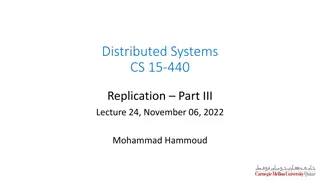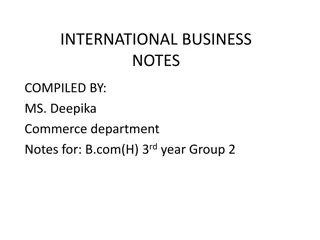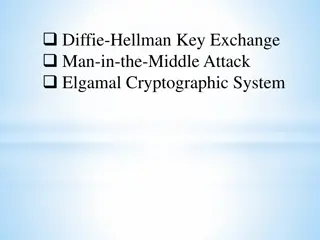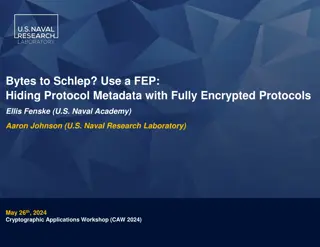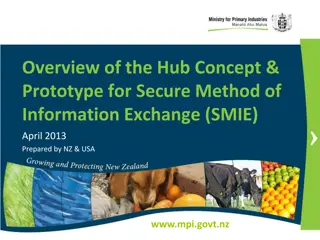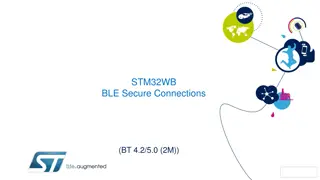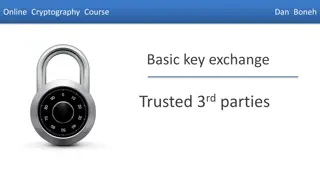Secure Composition of Key Exchange Protocols
Explore the game-based composition approach for key exchange protocols, focusing on ensuring security in compositions with arbitrary tasks and the universal composability of protocols. Delve into the Bellare-Rogaway security model and the details of security games in protocol analysis. Understand key agreement in two-party symmetric protocols within the context of game-based composition security.
Download Presentation

Please find below an Image/Link to download the presentation.
The content on the website is provided AS IS for your information and personal use only. It may not be sold, licensed, or shared on other websites without obtaining consent from the author.If you encounter any issues during the download, it is possible that the publisher has removed the file from their server.
You are allowed to download the files provided on this website for personal or commercial use, subject to the condition that they are used lawfully. All files are the property of their respective owners.
The content on the website is provided AS IS for your information and personal use only. It may not be sold, licensed, or shared on other websites without obtaining consent from the author.
E N D
Presentation Transcript
Game-based composition for key exchange Cristina Brzuska, Marc Fischlin (University of Darmstadt) Nigel Smart, Bogdan Warinschi, Steve Williams (University of Bristol)
Composition of key exchange with arbitrary tasks TLS Handshake Protocol K K use K for TLS Record Layer e.g. Secure Channel When is the composition secure? For modularity: sufficient condition on the key exchange to ensure security of the composition
Universal composability General composition results but... Too general? Assume preestablished session ids Generic (but not general) mechanism for dealing with shared state (JUC theorem) Too demanding? Does not support well adaptive corruption Commitment problem Does not seem to be easily applicable to practical protocols
Bellare-Rogaway Security(BR) K K The adversary controls the network and can mount insider attacks Keys should be indistinguishable from random, i.e.: The adversary chooses a session between two honest users and either gets the session key or a value drawn uniformly from {0,1}n. Adversary s goal: Distinguish between real and random. Intuition: If keys are as good as random, they can later be used for applications.
Security game queries answers Security game (Protocol) A 0/1
in a bit more details queries answers Game state (e.g. challenge bit b, corrupt vs non corrupt sessions) Winning condition (predicate): P_win
Game-based composition Key Agreement A Arbitrary two-party symmetric protocol 0/1 Composition: key agreement + symmetric key protocol Adversary can access key agreement phase and secure channel phase Adversary tries to break the security of the second part only In particular, no winning condition against the key agreement Session matching in key agreement phase via local, private sids
Game-based composition security A Game state Game state Winning condition (predicate): P_win
Game-based composition security A Game state Winning condition (predicate): P_win
Main Theorem ke Theorem: Let ke be a key agreement that: Is Bellare-Rogaway-secure Has a public session matching algorithm Let be an arbitrary symmetric-key protocol Secure for randomly generated keys ( is given by its algorithms and a security game) Then, the composition of ke and is secure. 0/1
Proof ke A B 0/1 B extracts session keys from key agreement to simulate the secure channel protocol. It uses the public session matching for consistent channel communication
Public Session matching is necessary Key Agreement A ``matching protocol B The ``matching protocol forces B to match sessions correctly, if A shall be helpful at all. The proof works for non-rewinding B.
TLS and BR-security TLS Handshake Protocol ENCK1(T,MACK2(0|T)) K1,K2 K1,K2 The key K1,K2 is used in the key agreement protocol. The adversary can easily distinguish the session key from random, i.e.: Session key: Decrypt with K1, check MAC with K2: valid. Random value: Decrypt with K1, check MAC with K2: invalid.
Idea: Good Key Agreement for As strong as necessary: If ke hurts security of protocol, then A wins. network + insider attacks A Key Agreement (ke) As weak as needed: No restrictions on syntax keys Application Protocol ( ) No restrictions on secrecy Still: Long composition proofs, if protocol is complicated Even if protocol security reduces to simple primitive, these composition proofs remain laborious. 0/1 Attack possibilities of both: ke and No winning condition for the key agreement, only winning condition of the application protocol.
ke Main Theorem keys If the ke is ``good for the primitive and if there is a key-independent reduction from to key-independent reduction the key agreement (ke) is good for the protocol . then ke keys
Reductions KeyGen KeyGen keys keys B A 0/1 0/1 Reduction: For all B there is a A such that the probabilities of the games outputting 1 are close, where the probability are taken over the random bits used by the adversary, the key generation and the game.
(Key-Independent) Reductions A1 A1 keys keys A2 B2 0/1 0/1 Key-Independent Reduction: For all (A1,B2) there is a A2such that the probabilities of the games outputting 1 are close, where the probability are taken over the random bits used by the adversary, the key generation and the game.
(Key-Independent) Reductions A1 A1 keys keys A2 B2 0/1 0/1 Restriction on the first stage of the adversary: Get old notion of reduction. KeyGen KeyGen For both kinds of reduction: If B2breaks protocols with certain keys, then A2breaks primitive with same keys. B keys keys A 0/1 0/1
ke Main Theorem keys If the ke is ``good for the primitive and if there is a key-independent reduction from to key-independent reduction the key agreement (ke) is good for the protocol . then ke keys
key-independent reduction Proof A1* A1* keys keys st st st st ke ke B1 B2 B1 A2 st st keys keys B2 A2 folding unfolding A1* A1* ke ke B1 B1 st st keys keys B2 A2
TLS Example TLS Handshake Protocol ENCK(T,MACK(0|T)) K1,K2= K K ENCK(m,MACK(counter|m)) TLS Record Layer
Roadmap Key-Independent Reduction: If you break the authenticity of the channel, then you can forge a MAC. If you break the secrecy of the channel, then you can break the ENC scheme. TLS Handshake Protocol ENCK(T,MACK(0|T)) K K is good for MAC and ENC. ENCK(m,MACK(counter|m)) TLS Record Layer reduces to MAC and ENC.
TLS Handshake Good for MAC/ENC Primitive ke A1 st keys ENCK(T,MACK(0|T)) A2 K is good for MAC and ENC. First step: Define the primitive : Mixed primitive of MAC and ENC, i.e.: The adversary wins if she breaks at least one of them. Additional modification: Weak primitive, i.e. the adversary may not output a forgery for the message MACK(0|Transcript). Second Step: Show that except for the last message, the key K looks as good as random (using random oracles). Final Step: Games are as good as independent now. Reduce weak primitive to strong primitive. K
Key-Independent Reduction Key-Independent Reduction: If you break the authenticity of the channel, then you can forge a MAC. Show that the TLS Record Layer can be reduced to weak primitive. Due to the use of counters, this is true. The adversary may not output a forgery for the message ENC (T,MAC (0|T)). ENC (m,MAC (counter|m)) TLS Record Layer reduces to MAC and ENC.
Conclusion Designed two composition theorems for key exchange protocols For BR-security, identified public matching as a necessary condition for general composability For protocols that use the key in the design, gave an alternative route for compositional analysis (applied it to TLS) More general game-based composition?












